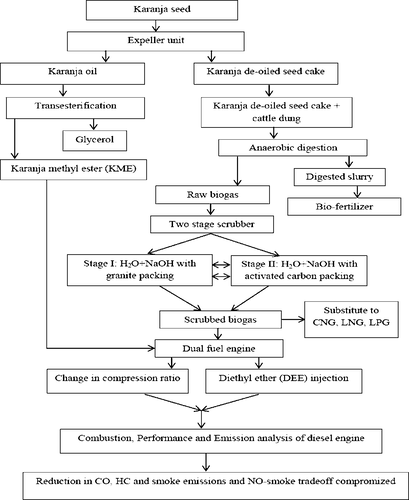当前位置:
X-MOL 学术
›
Energy Fuels
›
论文详情
Our official English website, www.x-mol.net, welcomes your feedback! (Note: you will need to create a separate account there.)
Effect of Compression Ratio on Combustion Performance and Emission Characteristic of a Direct Injection Diesel Engine Fueled with Upgraded Biogas–Karanja Methyl Ester–Diethyl Ether Port Injection
Energy & Fuels ( IF 5.3 ) Pub Date : 2018-03-19 00:00:00 , DOI: 10.1021/acs.energyfuels.7b01977 Debabrata Barik 1, 2 , Asit Kumar 2 , S. Murugan 2
Energy & Fuels ( IF 5.3 ) Pub Date : 2018-03-19 00:00:00 , DOI: 10.1021/acs.energyfuels.7b01977 Debabrata Barik 1, 2 , Asit Kumar 2 , S. Murugan 2
Affiliation

|
This work is an attempt to divulge the influence of compression ratio (CR) on the behavior of a 4.4 kW, single cylinder, air-cooled, diesel engine operated on upgraded biogas–Karanja methyl ester (UBG-KME) dual fuel. Earlier, an experiment was conducted by the authors to examine the use of UBG-KME-DEE (diethyl ether) in a dual fuel engine, and the results indicated that UBG-KME-DEE port injection functioned well and provided improved performance and lower emissions in comparison to the raw biogas RBG-KME-DEE mode. Nevertheless, the engine produced a lower brake thermal efficiency (BTE) compared to that obtained with diesel operation. Hence, to increase the BTE, experiments were conducted with varied CRs (16.5, 17.5, and 18.5) of the engine, KME was injected at a fixed timing of 24.5 °CA bTDC, DEE supply to engine was limited at 6%, and the UBG supply was made constant at 0.9 kg/h. The test results indicated that UBG-KME-DEE operation with CR = 18.5 gave optimum results. An increase in heat release rate of 60 J/°CA and shorter ignition delay of 7.8 °CA were observed for UBG-KME-DEE operation with CR = 18.5 at full operating load. BTE was increased and brake specific energy consumption was decreased, by about 7% and 6.8%, respectively, for UBG-KME-DEE operation with CR = 18.5 in comparison with KME. About 44, 42, and 42.8% decreases in the emissions of CO, hydrocarbons, and smoke were observed for UBG-KME-DEE at CR = 18.5. However, the emission of NO for UBG-KME-DEE operation with CR = 18.5 was 7.6% higher than with diesel, but 1.2% lower than with KME, at full operating load. The novel findings of this study raise the possibility of lowering the NO–smoke emission trade-off, which is a prime challenge in diesel engines. In addition, UBG-KME-DEE diesel engines (renewable nature) can substitute the use of diesel and compressed natural gas.
中文翻译:

压缩比对直喷柴油发动机升级后的沼气-卡拉汉甲酯-二乙醚端口喷射燃烧性能和排放特性的影响
这项工作是为了揭示压缩比(CR)对以升级的沼气-魔芋甲酸酯(UBG-KME)双燃料运行的4.4 kW单缸风冷柴油发动机的性能的影响。此前,作者进行了一项实验,以检查UBG-KME-DEE(二乙醚)在双燃料发动机中的使用,结果表明UBG-KME-DEE进气道喷射功能良好,并提供了改进的性能和更低的排放与原始沼气RBG-KME-DEE模式相比。但是,与柴油机运行相比,发动机产生的制动热效率(BTE)较低。因此,为了增加BTE,对发动机的各种CR(分别为16.5、17.5和18.5)进行了实验,在24.5°CA bTDC的固定时间注入了KME,向发动机提供的DEE限制为6%,UBG的供应量恒定为0.9 kg / h。测试结果表明,CR = 18.5的UBG-KME-DEE操作可获得最佳结果。对于UBG-KME-DEE,在满负荷工作时CR = 18.5的情况下,观察到放热速率提高了60 J /°CA,点火延迟缩短了7.8°CA。与KME相比,CRG = 18.5的UBG-KME-DEE操作的BTE增加了,制动器的单位能耗降低了约7%和6.8%。在CR = 18.5时,UBG-KME-DEE的CO,碳氢化合物和烟气排放量分别减少了约44、42和42.8%。但是,在满负荷运行时,CR = 18.5的UBG-KME-DEE运行的NO排放量比柴油高7.6%,但比KME低1.2%。这项研究的新颖发现提出了降低NO烟排放权衡的可能性,这是柴油发动机面临的主要挑战。此外,UBG-KME-DEE柴油发动机(可再生性质)可以替代柴油和压缩天然气的使用。
更新日期:2018-03-19
中文翻译:

压缩比对直喷柴油发动机升级后的沼气-卡拉汉甲酯-二乙醚端口喷射燃烧性能和排放特性的影响
这项工作是为了揭示压缩比(CR)对以升级的沼气-魔芋甲酸酯(UBG-KME)双燃料运行的4.4 kW单缸风冷柴油发动机的性能的影响。此前,作者进行了一项实验,以检查UBG-KME-DEE(二乙醚)在双燃料发动机中的使用,结果表明UBG-KME-DEE进气道喷射功能良好,并提供了改进的性能和更低的排放与原始沼气RBG-KME-DEE模式相比。但是,与柴油机运行相比,发动机产生的制动热效率(BTE)较低。因此,为了增加BTE,对发动机的各种CR(分别为16.5、17.5和18.5)进行了实验,在24.5°CA bTDC的固定时间注入了KME,向发动机提供的DEE限制为6%,UBG的供应量恒定为0.9 kg / h。测试结果表明,CR = 18.5的UBG-KME-DEE操作可获得最佳结果。对于UBG-KME-DEE,在满负荷工作时CR = 18.5的情况下,观察到放热速率提高了60 J /°CA,点火延迟缩短了7.8°CA。与KME相比,CRG = 18.5的UBG-KME-DEE操作的BTE增加了,制动器的单位能耗降低了约7%和6.8%。在CR = 18.5时,UBG-KME-DEE的CO,碳氢化合物和烟气排放量分别减少了约44、42和42.8%。但是,在满负荷运行时,CR = 18.5的UBG-KME-DEE运行的NO排放量比柴油高7.6%,但比KME低1.2%。这项研究的新颖发现提出了降低NO烟排放权衡的可能性,这是柴油发动机面临的主要挑战。此外,UBG-KME-DEE柴油发动机(可再生性质)可以替代柴油和压缩天然气的使用。



























 京公网安备 11010802027423号
京公网安备 11010802027423号